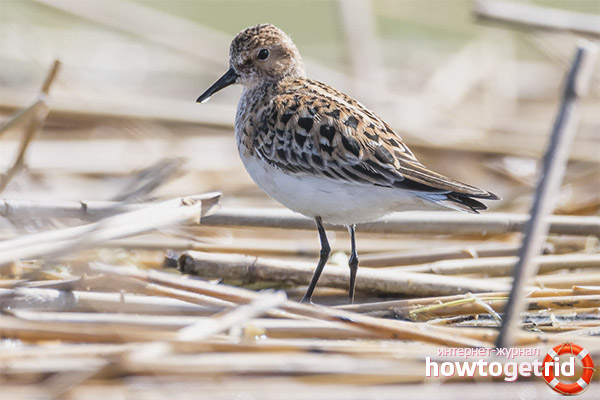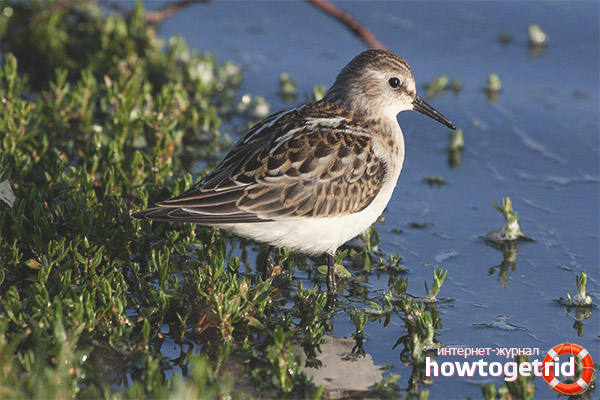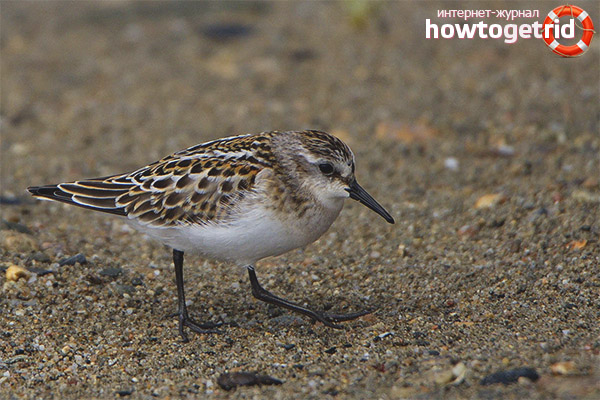The content of the article
For residents of a big city, the most common birds are pigeons, crows and sparrows - they are everywhere and everywhere, a look stumbles upon them anywhere in the urban landscape. In the wild, other birds are common, one of them is a sandpiper. Only in Russia they are inhabited by more than 70 species, united in three dozen genera. On the Russian territory lives one of the sandpiper species - sandpits, which include dwarfs, dwarfs, gerbils, and so on.
Without this bird, the tundra would be much more boring. Flocks of waders fill the endless tundra expanses with noise, din and various songs that they publish during the currents, they revive the thawed areas, which have just lost their snow, playing in the air. Outwardly, representatives of this species are very similar to an ordinary familiar dove, however there are many individual distinctive features that distinguish sandboxes from other waders. It will be about one of the many representatives of the sandbox species named Sandpiper.
Appearance
The weight is very small - from 20 to 33 gr., The length of the body is 12-15 cm, the wings are long but narrow - from 9 to 10.5 cm, the wingspan is 30 cm. According to external signs, there are practically no differences between the sexes. Unless the females are a little bigger.
Habitat
This small bird prefers to settle in the northern latitudes and selects tundra areas for living, settles near coastal water bodies, this is how it relates to near-water species. The habitat is wide - from the forests of Norway to the lower channel of the Lena. Sandpiper is sometimes found on some islands of the planet’s northernmost ocean - the Arctic Ocean. Sometimes it even climbs into the forest-tundra located south. It belongs to migratory birds; it hibernates in the South Asian regions, Africa, and in the south of the Caspian.
Returning from the southern warm regions to their native lands in late March - early April, the birds begin mating games - tokuyut. It looks like this: the male flies high up, raises its wings and twitches them. At the same time, he sings, uttering a trill, similar to the chirping of a grasshopper.
Nesting and breeding

They begin to nest depending on the climate. The nest is usually built under some stunted bush on a dry hill - a tubercle or mound. It searches for or makes a small hole, covers it with last year's old dry grass and stamps on it, priming. The bottom of the nest is lined with grass, leaves of yernik and leaves of growing dwarf trees - for example, dwarf willows. Often the boundaries of the nest are so blurred that it is worth pulling eggs out of it - and you may not understand where exactly the nest is.
The female lays 3-4 olive-brown eggs at the end of the first summer month, but sometimes their color is different. Then all the worries about the laying lay on the shoulders of the male - the female finds a new partner, mating games and toking begin again, and then makes laying from him. Or a lady can stay with the old one, build a new nest, lay 4 more eggs and hatch. It turns out that the couple has not one, like all birds, a nest, but two.
After 18 - 26 days, chicks covered with light down hatch.Almost immediately, the parents lead them out of the nest, continuing to take care of the children, warm them during the cold weather, protect them from dangers and supply them with food. After two weeks, the children are fully fledged, but so far they can’t fly. As soon as the grown children begin to flutter, the parents immediately leave them, and the young begins an independent life.
Nutrition

Sandpiper - a bird, mainly carnivorous, feeds on animal food. It collects in shallow areas of water near open reservoirs, where there is little vegetation, insects such as ground beetles, in the water catches mollusks, crustaceans, water bugs, bloodworm larvae and other aquatic insects. Sometimes it collects and pecks seeds from some plants. It feeds on land with small pecks, picking up food, probes sludge in the water, finding the prey by touch and eating it.
Their favorite insect is the locust. Sandpipers are ready to walk endlessly on the grass, searching for and destroying this pest.
Interesting Facts
Sparrow sandpiper is not a shy bird, has a balanced calm character and trusts not only other representatives of birds, but also a person. When a sandpiper hatches eggs, you can come close to the nest without fear that it will fly away. He just starts to run around the house, stomp on the spot, bounce, quietly squeak, and try to get the stranger away from the nest. If you just lie low, sitting calmly and not making any movements, then the bird calms down, sits back and continues to hatch, as if nothing had happened.
Life expectancy is quite large - about two decades.
Young chicks from different families, left by their parents for an independent life, are combined into one large group. This usually happens in the second decade of August. And this flock a whole month - one and a half until the fall wanders around the expanses of the tundra, preparing for the upcoming flight.
Sandpipers fly away for the winter sometimes to very distant lands - you have to overcome a distance of up to 10,000 kilometers. Being near-water birds, they choose, respectively, places near the water for recreation. They sit on the banks of rivers, lakes, salt marshes, reservoirs.
Video: Sparrow Sandpiper (Calidris minuta)










Submit